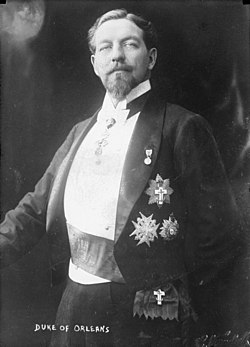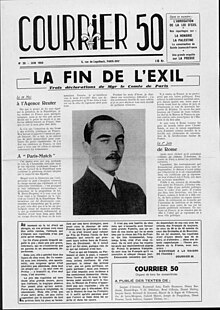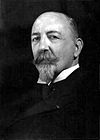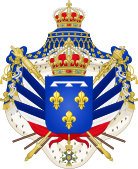Orléanist

Orléanist (French: Orléaniste) was a 19th-century French political label originally used by those who supported a constitutional monarchy expressed by the House of Orléans.[1] Due to the radical political changes that occurred during that century in France, three different phases of Orléanism can be identified:
- The "pure" Orléanism: constituted by those who supported the constitutional reign of Louis Philippe I (1830–1848) after the 1830 July Revolution, and who showed liberal and moderate ideas.[2]
- The "fusionist" (or "unionist") Orléanism: the movement formed by pure Orléanists and by those Spanish Bourbons on account of their "foreigness") and Catholicism.[4]
- The "progressive" Orléanism: the majority of "fusionists" who, after the decline of monarchist sentiment in the 1890s, joined into moderate republicans, who showed progressive and secular-minded goals,[5] or into Catholic rally, like the Liberal Action.[6]
Orleanism was opposed by the two other monarchist trends: the more conservative
Under the July Monarchy

On 26 July 1830, the revolution of the so-called Three Glorious Days (or July Revolution) erupted due to the authoritarian and anti-Gallican tendencies showed by Charles X and his Prime Minister Jules de Polignac, expressed by the recently approved Saint-Cloud Ordinances.[7][8] Despite the abdication of Charles X and the Dauphin Louis in favor to Charles X's grandson Henri, Duke of Bordeaux, on 2 August 1830, only seven days later Louis Philippe I, still Duke of Orléans, was elected by the Chamber of Deputies as new "King of the French".[9] The enthronement of Louis Philippe was strongly wanted by Doctrinaires, the liberal opposition to Charles X's ministries, under the concept "nationalize the monarchy and royalize France".[10] On 14 August 1830, the Chamber approved a new Constitution, who became the de facto political manifesto for the Orléanists, containing the basis for a constitutional monarchy with a central Parliament. The Orléanism, became the dominant tendency within political life, easily divided inside the Chamber of Deputies between the centre-left of Adolphe Thiers[11] and the centre-right of François Guizot.[12] Louis Philippe showed himself more aligned with Guizot, entrusted to the higher offices of government, and rapidly became associated with the rising "new men" of the banks, industries and finance,[13] gaining the epithet of "Roi bourgeois".[14] In the early 1840s, Louis Philippe's popularity decreased, due to his strong connection to upper classes and repression against workers' strikes, and showed few concerns for his weakened position, leading the writer Victor Hugo to describe him as "a man with many little qualities".[15] The Orléanist regime finally fell in 1848, when a revolution erupted and on 24 February Louis Philippe abdicated in favor to his grandson Philippe, Count of Paris, under regency of his mother Helene, Duchess of Orléans, who was quickly ousted out from the Chamber of Deputies during the regency's formalization, who was interrupted by republican deputies who instead proclaimed the Second Republic.[16]
After 18 years of reign, Louis Philippe left the Orléanist base well-defined inside the magistrature, the press, universities and academies, especially the
Under the Third Republic
Fusion and restoration project
| Electoral results | |||||
|---|---|---|---|---|---|
| Year | No. of overall votes |
% of overall vote |
No. of overall seats won | ||
| National Assembly | |||||
| 1871 | Unknown (1st) | 33.5% | 214 / 638
| ||
| Chamber of Deputies | |||||
| 1876 | 554,117 (6th) | 7.5% | 40 / 533
| ||
| 1877 | 169,834 (5th) | 2.1% | 11 / 521
| ||
| 1881 | 552,971 (5th) | 7.7% | 42 / 545
| ||
| 1885 | 991,188 (4th) | 12.2% | 73 / 584
| ||
| 1889 | 994,173 (4th) | 12.5% | 72 / 576
| ||
| 1893 | 816,789 (3rd) | 10.5% | 63 / 574
| ||
| 1898 | 607,960 (5th) | 7.5% | 44 / 585
| ||


Orléanism revived after the French defeat in the
Due to Chambord's dislike of Aumale,
The monarchists, however, still controlled the National Assembly, and under MacMahon's partisan presidency they launched the so-called "moral order government", in reference to the Paris Commune, whose political and social innovations were viewed as morally degenerate by large conservative segments of the French population.[28] In February 1875, a series of parliamentary acts established the
The end of the presidency of MacMahon and the Senate's loss caused the end of the monarchist bloc. Although there were Orléanist deputies in the Chamber for all the 19th century, they were only a minority. At the end, many monarchists accepted the republic, moving toward the centre. Some Orléanists, especially from their bourgeoise core base, accepted the republic even since the 1870s, like Thiers and press baron
Association with the far-right

| This article is part of Conservatism in France |
 |
The
By 1934, the Action was still a considerable force, with over 60,000 members across France.[41] In that year, they joined other far-right leagues on 6 February demonstrations against political corruption and the Parliament, causing the resignation of Prime Minister Édouard Daladier the day after and provoking fear of a nationalist coup d'état.[42] The papal condemnation, the aggressive tactics, and Maurras's disrespectful attitude toward constitutional monarchists finally ended the organization as a major power. The Orléanist pretender Jean, Duke of Guise, who in 1937 broken ties with the Action, also lost many supporters. From this moment, Orléanism ceased to be associated with the Action or the far-right.[16] Instead, the Duke of Guise's son and heir Henri, Count of Paris, launched his own magazine Courier Royale and secretly dealt with anti-fascist conservative General La Rocque, leader of the French Social Party, about the possibility of a restoration.[43]
Hope during the Fourth Republic

In 1946, the Count of Paris (who succeeded his father in 1940) moved to Portugal due to the ban on former royals still present in France. As a result of the unstable situation of the Fourth Republic, characterized like its predecessor by short governments and a high number of political parties, the Count of Paris made a serious attempt to restore the French monarchy. He endorsed the Christian Democratic Popular Republican Movement (MPR), and formed a kind of political committee composed of the academics Bertrand de Jouvenel, Gustave Thibon and Michel de Saint Pierre,[44] publishing on 5 February 1948 the manifesto Esquisse d'une constitution monarchique et démocratique, that promoted the idea of a constitutional monarchy.[44] Thanks to the MPR deputy Paul Hutin-Desgrées (co-founder of Ouest-France), the exile law was abrogated on 24 June 1950, permitting the return of the Count of Paris to the capital, where he met with President Vincent Auriol.[44] The count and his family made their home in the Parisian suburbs of Louveciennes, and quickly became media darlings. Orléans frequently went to parties and meetings which were attended by prominent French politicians of the Fourth Republic, such as Antoine Pinay, Jacques Soustelle, Pierre Mendès France and Maurice Schumann.[44] Through his newsletter Courier 50, the Count of Paris expressed support for the policies of Mendès France, like the peace in Indochina, the refusal of a US-controlled European Defence Community (EDC) and decolonization of French Africa.[44]
Orléans' relationship with Charles de Gaulle was also promising, as the general and the pretender had similar political views and were both devout Roman Catholics.[44] When De Gaulle became prime minister in 1958, it was expected by the Count of Paris that the general would move to restore the French monarchy, but instead De Gaulle preferred to strengthen the republican institutions, eventually becoming the driving force behind the establishment of the present-day Fifth Republic. De Gaulle was elected president of the new government in 1959, and seems to have promised the Count of Paris that he wouldn't run again in the election of 1965, instead supporting the candidacy of the pretender that would promote a campaign to transform the republic into a constitutional monarchy.[45] However, in 1963 De Gaulle confided to his minister Alain Peyrefitte that, despite his respect and esteem for the Count of Paris, he never considered him to be his successor as the head of state, stating that the idea of a monarchy was incompatible with the modern world.[46] Disappointed by the false hopes and unfulfilled promises, the Count of Paris retired from French political life in 1967, ending also the publications of his newsletter.
Principles of succession
Orléanist pretenders from 1883 to the present follow these principles:
- The Crown passes by primogeniture to males born in the male line of Hugh Capet.
- Only children born of legal marriages conforming with the canon law of the Catholic Church are dynasts.
- The Sovereign or Head of the House can neither abdicate nor alter the line of succession. The Princes of the blood likewise cannot personally renounce theirs succession rights. Those rights can however be permanently lost under specific circumstances (see below).
- The throne is never vacant; upon the death of the Sovereign or Head of the House, the first in line automatically succeeds, regardless of any coronation or whether actually reigning.
- The Sovereign or Head of the House must be Catholic.
- The Sovereign or Head of the House must be both French and born of an unbroken line of French dynasts descending from Hugh Capet. Any prince of the blood that leaves France to claim a foreign throne or a position subject to which permanently loses his rights of succession, as do his descendants.[47] It is this rule that separates the Orléanist rule from the Legitimist one.
List of claimants to the French throne since 1848
| Claimant | Portrait | Birth | Marriages | Death |
|---|---|---|---|---|
| Philippe, Count of Paris (Louis Philippe II) 1848–1873 Orléanist pretender (Philippe VII) 1883–1894 Unionist pretender |
 |
24 August 1838 Paris Son of Duchess Helen of Mecklenburg-Schwerin |
Princess Marie Isabelle of Orléans 30 May 1864 8 children |
8 September 1894 Stowe House Aged 56 |
Philippe, Duke of Orléans (Philippe VIII) 1894–1926 |
 |
24 August 1869 York House, Twickenham Son of Philippe, Count of Paris and Princess Marie Isabelle of Orléans |
Archduchess Maria Dorothea of Austria 5 November 1896 No children |
28 March 1926 Palermo Aged 56 |
| Jean, Duke of Guise (Jean III) 1926–1940 |
 |
4 September 1874 France Son of Marie-Françoise of Orléans |
Isabelle of Orléans 30 October 1899 4 children |
25 August 1940 Larache, Spanish Morocco Aged 65 |
| Henri, Count of Paris (Henri VI) 1940–1999 |
 |
5 July 1908 Chateau de Nouvion-en-Thiérache, Isabelle of Orléans |
Isabelle of Orléans-Braganza 8 April 1931 11 children |
19 June 1999 Chérisy Aged 90 |
| Henri d'Orléans, Count of Paris (Henri VII) 1999–2019 |
 |
June 14, 1933 Isabelle of Orléans-Braganza |
31 October 1984 (Civil) 26 September 2009 (Religious) |
21 January 2019 Paris Aged 85 |
| Jean, Count of Paris (Jean IV) 2019–present |
 |
May 19, 1965 Boulogne-Billancourt, Paris, France Son of Henri, Count of Paris and Marie-Thérèse of Württemberg |
Philomena de Tornos Steinhart 19 March 2009 5 children |
Orléanist political parties
- Doctrinaires (1815-1848)
- Resistance Party (1832-1848)
- Movement Party (1831-1848)
- Party of Order (1848-1852)
- Action Française (1899- )
Legacy
This section needs additional citations for verification. (January 2024) |
| French royal family Orléanist |
|---|
 |
|
The Orléanist party, despite the different regimes, maintained its
In the early 20th century, the majority of Orléanists accepted the republican institutions, approving the parliamentary system and pro-business policy realized by the republican majority, who reflected the historical Orléanist purposes.[6] French historian René Rémond included the presidency of Valéry Giscard d'Estaing as part of the Orléanist tradition, due to his liberal views and equidistance from the nationalist right (descending from Bonapartism) and the conservative right (from Legitimism).[50] The term "Orléanist parliamentarism" was also used by jurist and sociologist Maurice Duverger to define the form of government of the Fifth Republic, which presents a parliamentary system with a powerful head of state.[51]
In 1974, before the presidential election, the New Royal Action (NAR), born by a moderate faction spilled from the Action française, endorsed Bertrand Renouvin for the presidency, with the purpose of restoring a constitutional monarchy led by Orléans, followed by centrist and liberal positions on other issues. Renouvin gained only 43,722 votes (0.17%).
See also
- Succession to the former French throne (Orléanist)
- Succession to the French throne
- French dynastic disputes
- Alliance Royale
- New Royalist Action
- French Action
Bibliography
- This article incorporates text from a publication now in the public domain: Chisholm, Hugh, ed. (1911). "Orleanists". Encyclopædia Britannica (11th ed.). Cambridge University Press.
- Aston, Nigel (1988). Orleanism, 1780–1830. Vol. 38.
{{cite book}}:|work=ignored (help) - Broglie, Gabriel de (1981). Perrin (ed.). L'Orléanisme: La ressource libérale de la France (in French). Perrin (réédition numérique FeniXX). ISBN 9782262054014.
- Broglie, Gabriel de (2011). Fayard (ed.). La Monarchie de Juillet (in French).
- Robert, Hervé (1992). PUF (ed.). L'orléanisme (in French). (Presses universitaires de France) réédition numérique FeniXX. ISBN 9782705928605.
- Beik, Paul (1965). Van Nostrand Reinhold (ed.). Louis Philippe and the July Monarchy.
- Collingham, H. A. C. (1988). Longman (ed.). The July Monarchy: A Political History of France, 1830–1848.
- Howarth, T. E. B. (1962). Citizen-King: The Life of Louis Philippe, King of the French.
- Poisson, Georges (1999). Perrin (ed.). Les Orléans, Une famille en quête d'un trône (in French).
- Newman, Edgar; Simpson, Robert (1987). Greenwood Press (ed.). Historical Dictionary of France from the 1815 Restoration to the Second Empire. Archived from the original on 2011-06-28. Retrieved 2017-09-07.
- Rémond, René (1966). University of Pennsylvania Press (ed.). The Right Wing in France: From 1815 to de Gaulle.
- Passmore, Kevin (2013). The Right in France from the Third Republic to Vichy. Oxford University Press. pp. 25–26.
- Montplaisir, Daniel de (2008). Perrin (ed.). Le Comte de Chambord, dernier roi de France (in French).
- Montplaisir, Daniel de (2011). Jacob-Duvernet (ed.). Louis XX, petit-fils du roi Soleil (in French).
References
- ^ "Le dictionnaire de l'Histoire - Légitimiste, orléaniste". Herodote.net (in French).
- ^ Broglie 2011, p. 464.
- ^ Poisson, Georges (2009). Pygmalion (ed.). Le comte de Chambord: Henri V (in French). p. 316.
- ^ Robert 1992, pp. 39–40.
- ^ Rémond 1966, pp. 163–169.
- ^ a b c d e f g h Rémond (1966).
- ISBN 9781405198073
- )
- ^ "Louis-Philippe Biography". The Biography.com Website. Retrieved 13 May 2014.
- ^ One or more of the preceding sentences incorporates text from a publication now in the public domain: Chisholm, Hugh, ed. (1911). "Doctrinaires". Encyclopædia Britannica. Vol. 8 (11th ed.). Cambridge University Press. p. 367.
- ^ Agulhon, Maurice (1983). The Republican Experiment, 1848–1852. Cambridge University Press. p. 135.
- ^ Passmore 2013, pp. 25–26.
- ^ Demeester, Emma (2016). "François Guizot, du libéralisme au conservatisme". La Nouvelle Revue d'histoire, n.89 (in French). pp. 32–34.
- ^ Bienfait, Bérangère (October 30, 2018). "Louis-Philippe, un roi bourgeois, bâtisseur et entrepreneur". Point de Vue (in French). Archived from the original on November 5, 2018. Retrieved April 25, 2019.
- ^ Hugo, Victor (1972). Gallimard (ed.). Choses vues 1847–1848 (in French). p. 248.
- ^ a b Poisson (1999).
- ^ Lancien, Didier (2007). Maison des Sciences de l'Homme (ed.). Anciennes et nouvelles aristocraties: De 1880 à nos jours (in French). pp. 100–101.
- ^ "Parti de l'Ordre". Larousse.
- ^ Pinoteau, Hervé (1983). Nouvelles Editions Latines (ed.). Etat de l'Ordre du Saint-Esprit en 1830 ; et, La survivance des ordres du roi (in French).
- ^ Lejeune, Dominique (1994). Armand Colin (ed.). La France des débuts de la IIIe République, 1870–1896 (in French). p. 10.
- ^ La Besge, Émile de (1971). Perrin (ed.). Souvenir et récits de chasse (in French).
- ^ Dreux-Brézé, Henri de (1899). Perrin (ed.). Notes et Souvenirs pour servir à l'histoire du parti royaliste (in French). pp. 227–234.
- ^ Mayeur, Jean-Marie (1984). Seuil (ed.). La Vie politique sous la IIIe République. p. 44.
- ^ a b c Montplaisir (2008).
- ^ Broglie, Albert de (1929). La Revue des Deux Mondes (ed.). Mémoires, IIIe partie, l'avènement de la République (II) (in French). Vol. LIV. p. 594.
- ^ Broglie, Gabriel (2000). Perrin (ed.). MacMahon (in French). pp. 247–251.
- ^ Dale, Steven D. (1988). The Monarchy According to the King: The Ideological Content of the 'Drapeau Blanc,' 1871–1873. Vol. II. pp. 399–426.
{{cite book}}:|work=ignored (help) - ^ Brogan, D.W. Brogan (1940). Greenwood Press (ed.). France Under the Republic: The Development of Modern France (1870–1939). pp. 106–13.
- ^ Brogan (1940) pp. 127–43.
- ^ "François Paul Jules Grévy is Born". Masonry Today. 2017.
- ^ "Jules Grevy". World Presidents DB. 2017.
- ^ Pope Leo XIII (February 16, 1892). Inter Sollicitudines.
- ^ Piou, Jacques (1914). Hachette (ed.). Le comte Albert de Mun (in French). p. 206.
- ^ Jaurès, Jean (1933). Rieder (ed.). Études socialistes II, 1897–1901 (in French). pp. 189–218.
- ^ Bredin, Jean-Denis (1983). France Loisirs (ed.). L'Affaire (in French). p. 475.
- ^ Levy, Richard S. (2005). ABC-CLIO (ed.). Antisemitism: A historical encyclopedia of prejudice and persecution. p. 191.
- ^ Giocanti, Stéphane (2006). Flammarion (ed.). Charles Maurras: le chaos et l'ordre (in French). p. 167.
- ^ Rouvillois, Frédéric (2005). Flammarion (ed.). Droit constitutionnel: Fondements et pratiques (in French). p. 191.
- ^ Latourette, Kenneth (1969). Zondervan (ed.). Christianity in a Revolutionary Age. pp. 37–38.
- ISBN 9780804701341. Archivedfrom the original on 5 May 2016.
- ^ Schor, Ralph (2005). Complexe (ed.). L'antisémitisme en France dans l'entre-deux-guerres: prélude à Vichy (in French). p. 29.
- ^ Colton, Joel (1969). Warner (ed.). From the Ancien Regime to the Popular Front. p. 183.
- ^ J. F. (October 22, 1938). "Comment j'ai été "kidnappé" par le comte de Paris". Le Populaire (in French).
- ^ a b c d e f Montplaisir (2011).
- ^ Natal, Frederic (October 1, 2016). La couronne (ed.). "Le général Charles de Gaulle a-t-il voulu restaurer la monarchie?" (in French).
- ^ Peyrefitte, Alain (1997). Fayard (ed.). C'était de Gaulle. Vol. II. pp. 531–533.
- ^ If however, the prince receives certain letters patent from the king or head of house prior to their departure (the purpose of which is to preserve the French nationality of the prince in question, as well as granting it to his male descendants despite their potential births abroad) they maintain their position in the line of succession. These documents can however be revoked if parliament deem necessary, at which point the prince in question and his branch of the house irrevocably lose their nationality, and by extension their rights of succession.
- ^ Craiutu, Aurelian (2003). Liberalism under Siege: The Political Thought of the French Doctrinaires. Lexington Books. p. 9.
- ^ Takeda, Chinatsu (2018). Mme de Staël and Political Liberalism in France. Springer. pp. 226–227.
- ^ Slama, Alain-Gérard Slama (2006). Vous avez dit bonapartiste?. pp. 60–63.
{{cite book}}:|work=ignored (help) - ^ Duverger, Maurice (1959). "Les institutions de la Ve République". Revue française de science politique, n. 1.
External links
- The French Unionist Project (representing fusionist Orléanism)
